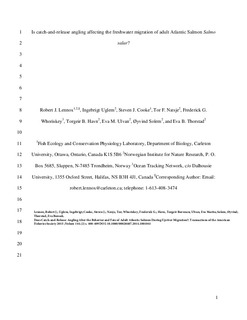Does Catch-and-Release Angling Alter the Behavior and Fate of Adult Atlantic Salmon During Upriver Migration?
Lennox, Robert J.; Uglem, Ingebrigt; Cooke, Steven J.; Næsje, Tor; Whoriskey, Frederick G.; Havn, Torgeir Børresen; Ulvan, Eva Marita; Solem, Øyvind; Thorstad, Eva Bonsak
Journal article, Peer reviewed
Accepted version

View/
Date
2015Metadata
Show full item recordCollections
- Publikasjoner fra CRIStin - NINA [2397]
- Scientific publications [1423]
Original version
Transactions of the American Fisheries Society. 2015, 144 (2), 400-409. 10.1080/00028487.2014.1001041Abstract
To reproduce, Atlantic Salmon Salmo salar return to freshwater rivers and migrate upriver to spawning areas. This migration is the basis for recreational fisheries, which for conservation reasons are increasingly characterized by catchand- release angling. The effectiveness of catch and release for Atlantic Salmon conservation is contingent on the ability of individuals to recover fromangling, resumemigration, and reach spawning grounds at appropriate times.Wemonitored 27 caught and released Atlantic Salmon in RiverGaula in 2013, a prominent and relatively pristine Norwegian river, by affixing external radio transmitters to them. Those fish were compared with a control group of 33 individuals caught and radio-tagged at sea in bag nets before river entry. Whereas none of the control fish died during the study period, there were three mortalities among the caught-and-released fish (11%; significant difference). All mortalities were qualitatively associated with poor angler care, emphasizing the responsibility of anglers in practicing effective catch and release of Atlantic Salmon. Both control and caught and released Atlantic Salmon spent similar time resting below and in transiting a large natural barrier to migration, an 80-mgorge. The angled and released Atlantic Salmon were distributed in similar locations throughout the river during the spawning season compared with control fish, but those caught and released later in the season appeared to migrate shorter total distances than control fish. Among the caught and released Atlantic Salmon, 17% were recaptured by anglers, which was similar to the rate of recapture of the control fish (21%). Ultimately, individual and population fitness was not likely to be significantly compromised as a result of catch and release because individuals were recorded in spawning areas at appropriate times. Catch and release can therefore be considered a tenable strategy for balancing the costs and benefits associated with the recreational fishery